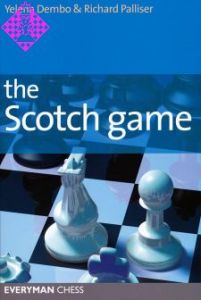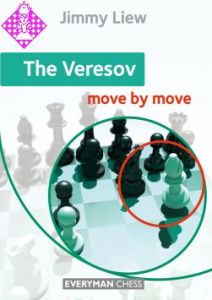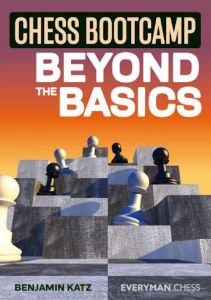Article Number
LOEMMTSIC2ND
Author
The Sicilian - 2nd edition
303 pages, paperback, Everyman, 2. edition 2009, first edition 2002
From the series »Starting Out«
This is an updated and largely expanded edition of Starting Out: The Sicilian, the highly acclaimed guide to the most popular and famous opening in chess. In this user-friendly book, Grandmaster John Emms goes back to basics, studying the fundamental principles of the Sicilian Defence and its many variations. Throughout the book there are an abundance of notes, tips, warnings and exercises to help the improving player, while key strategies, ideas and tactics for both sides are clearly illustrated.
The greatest attraction of the Sicilian is that it allows Black to unbalance the position and play for a win, without having to take any unjustified risks. Its many variations range from the super-solid Scheveningen to the dangerous and ultra-sharp Dragon. For those playing Black it should be easy to find one that suits your style, while those playing White can choose from the range of options given against each line.
It's probably safe to say that the Sicilian Defence is the most famous chess opening of all time. It's certainly the most popular: almost a quarter of all games in chess are Sicilian Defences. This is a pretty large fraction considering the large pool of openings from which each player can choose. If you play 1 e4, the likelihood of facing a Sicilian Defence is just below fifty percent.
Why the immense popularity? The easiest way to address this question is to take a look at some simple opening positions.
1 e4 is one of the two most popular opening moves for White (the other is 1 d4). With 1 e4 White gains control of some central squares and opens lines of development for his queen and f1-bishop. Give White another free move and what would he like to play? The answer of course is 2 d4!, controlling more central squares and opening further lines of development. With control of the cenand open lines for easy development, White is already assured of a good position from the opening moves.
Black has many possible replies to 1 e4, but only two of these both gain a foothold in the centre and dissuade White from carrying out his 'threat'. These two moves are 1...e5 (symmetrical king's pawn) and 1...c5 (the Sicilian). It's no coincidence that these are the two most popular defences to 1 e4, but what is interesting is that at most levels the Sicilian occurs twice as often as 1...e5. Why should that be the case?
Let's take a look at the position after 1...c5.
Black has taken control of the crucial d4-square and is ready to answer d2-d4 with ...cxd4, thus eliminating one of White's central pawns and lessening White's control of the centre. The 'advantage' the Sicilian has over, say, 1...e5 is that Black is able to unbalance the position with an asymmetrical pawn structure from an early stage. This allows both sides the opportunity to play for a win from the very start, White is less likely to acquire a 'risk free' edge because the position will always contain some imbalance.
Pawn Structures
Two-thirds of this book deals with 'Open Sicilian' positions, in which White plays 2 Nf3 followed by 3 d4. This is by far the most common way for White to meet the Sicilian. White opens more lines for his pieces and attempts to exploit the fact that he will be ahead in development.
Let's take a look at the possible opening moves 1 e4 c5 2 Nf3 d6 3 d4 cxd4. White is up in development and can move his pieces more freely. Black, however, has a structural advantage of an extra central pawn, which gives him long-term chances of taking control of the centre. A typical imbalance has arisen. The onus is on White to exploit his lead in development in order to secure an early initiative. If White plays passively or his initiative runs out of steam, then typically it's Black, with the better pawn structure, who enjoys the long-term chances. Thus it's quite rare for a state of 'dull equality' to arise. Often in the Sicilif Black 'equalizes', he is already slightly better! This structural advantage is seen in most Open Sicilian lines: for example, the Dragon, the Najdorf, the Scheveningen and the Classical Variations. The major exception to this rule is the Sveshnikov Variation, in which Black accepts pawn weaknesses in return for ac
Sicilian Variations
A few words on how this book is set out. In the first five chapters we shall be taka look at the most popular variations of the Open Sicilian: the Dragon, the Nathe Scheveningen, the Sveshnikov and the Classical. There are naturally many similar characteristics to these lines but they all contain their own distincflavour. In Chapter 6 we move on to slightly less common variations of the Open Sicilian: the Taimanov, the Four Knights, the Kan, the Accelerated Dragon and the Kalashnikov. In Chapters 7-9 we study lines in which White avoids the complexities of the Open Sicilian: Bb5 systems (Chapter 7); the c3 Sicilian (Chapter 8); and finally the Closed Sicilian, the Grand Prix Attack, the Morra Gambit and unusual lines (Chapter 9).
About the Second Edition
First of all I should stress that this is still a Starting Out book, and as such I hope it will appeal to a similar audience to those who read the first edition published in 2002. However, in this second edition I have taken the opportunity to cover the Sicilian more deeply, expanding on both the ideas and the theory, and widening the coverage to include new developments (one example is the Dragadorf Variasee Game 5) as well as less common lines which didn't make the first edition. So in effect, as well as Starting Out, there is also some degree of 'following on'. I've updated and expanded both the section introductions and the illustrative games from the first edition. I've also added over 20 new games, virtually all of which were played in the new millennium. In general I've chosen the games to illustrate some of the more entertaining and instructive Sicilian battles over the years, not always necessarily those which reflect the current state of theory (this task is sometimes confined to the notes of games and section introductions).
All in all, the additions and amendments have resulted in a considerably bigger book, one that's almost twice the size (in the number of words) of the first edition. Of course in this day and age, whatever the size, a single publication on the Sicilcould never hope to provide comprehensive coverage - far from it when you consider whole books have been devoted to a single sub-variation of the Sicilian! What I've aimed to do is to concentrate on the most popular lines - both modern day and historically - and those which a newcomer to the Sicilian is most likely to face. As I stressed in the first edition, more than anything this book aims to be an introduction to the main lines and ideas of the Sicilian, and to help readers choose variations they think will suit their style. I hope this book achieves its objective.
The only thing remaining is to wish you the best of luck in your Sicilian adven
John Emms,
Kent,
January 2009
The greatest attraction of the Sicilian is that it allows Black to unbalance the position and play for a win, without having to take any unjustified risks. Its many variations range from the super-solid Scheveningen to the dangerous and ultra-sharp Dragon. For those playing Black it should be easy to find one that suits your style, while those playing White can choose from the range of options given against each line.
·
Expanded to include new developments and more variations
·
Concentrates on the key principles of the Sicilian
·
Ideal for the improving player
John Emms is one of the UK's leading Grandmasters and has captained the English Team at two Chess Olympiads. He's an experienced coach who has worked with many top players, including World Championship finalist Michael Adams. He's also a highly respected writer; previous works for Everyman Chess include Discovering Chess Openings and The Survival Guide to Competitive Chess.
IntroductionIt's probably safe to say that the Sicilian Defence is the most famous chess opening of all time. It's certainly the most popular: almost a quarter of all games in chess are Sicilian Defences. This is a pretty large fraction considering the large pool of openings from which each player can choose. If you play 1 e4, the likelihood of facing a Sicilian Defence is just below fifty percent.
Why the immense popularity? The easiest way to address this question is to take a look at some simple opening positions.
1 e4 is one of the two most popular opening moves for White (the other is 1 d4). With 1 e4 White gains control of some central squares and opens lines of development for his queen and f1-bishop. Give White another free move and what would he like to play? The answer of course is 2 d4!, controlling more central squares and opening further lines of development. With control of the cenand open lines for easy development, White is already assured of a good position from the opening moves.
Black has many possible replies to 1 e4, but only two of these both gain a foothold in the centre and dissuade White from carrying out his 'threat'. These two moves are 1...e5 (symmetrical king's pawn) and 1...c5 (the Sicilian). It's no coincidence that these are the two most popular defences to 1 e4, but what is interesting is that at most levels the Sicilian occurs twice as often as 1...e5. Why should that be the case?
Let's take a look at the position after 1...c5.
Black has taken control of the crucial d4-square and is ready to answer d2-d4 with ...cxd4, thus eliminating one of White's central pawns and lessening White's control of the centre. The 'advantage' the Sicilian has over, say, 1...e5 is that Black is able to unbalance the position with an asymmetrical pawn structure from an early stage. This allows both sides the opportunity to play for a win from the very start, White is less likely to acquire a 'risk free' edge because the position will always contain some imbalance.
Pawn Structures
Two-thirds of this book deals with 'Open Sicilian' positions, in which White plays 2 Nf3 followed by 3 d4. This is by far the most common way for White to meet the Sicilian. White opens more lines for his pieces and attempts to exploit the fact that he will be ahead in development.
Let's take a look at the possible opening moves 1 e4 c5 2 Nf3 d6 3 d4 cxd4. White is up in development and can move his pieces more freely. Black, however, has a structural advantage of an extra central pawn, which gives him long-term chances of taking control of the centre. A typical imbalance has arisen. The onus is on White to exploit his lead in development in order to secure an early initiative. If White plays passively or his initiative runs out of steam, then typically it's Black, with the better pawn structure, who enjoys the long-term chances. Thus it's quite rare for a state of 'dull equality' to arise. Often in the Sicilif Black 'equalizes', he is already slightly better! This structural advantage is seen in most Open Sicilian lines: for example, the Dragon, the Najdorf, the Scheveningen and the Classical Variations. The major exception to this rule is the Sveshnikov Variation, in which Black accepts pawn weaknesses in return for ac
Sicilian Variations
A few words on how this book is set out. In the first five chapters we shall be taka look at the most popular variations of the Open Sicilian: the Dragon, the Nathe Scheveningen, the Sveshnikov and the Classical. There are naturally many similar characteristics to these lines but they all contain their own distincflavour. In Chapter 6 we move on to slightly less common variations of the Open Sicilian: the Taimanov, the Four Knights, the Kan, the Accelerated Dragon and the Kalashnikov. In Chapters 7-9 we study lines in which White avoids the complexities of the Open Sicilian: Bb5 systems (Chapter 7); the c3 Sicilian (Chapter 8); and finally the Closed Sicilian, the Grand Prix Attack, the Morra Gambit and unusual lines (Chapter 9).
About the Second Edition
First of all I should stress that this is still a Starting Out book, and as such I hope it will appeal to a similar audience to those who read the first edition published in 2002. However, in this second edition I have taken the opportunity to cover the Sicilian more deeply, expanding on both the ideas and the theory, and widening the coverage to include new developments (one example is the Dragadorf Variasee Game 5) as well as less common lines which didn't make the first edition. So in effect, as well as Starting Out, there is also some degree of 'following on'. I've updated and expanded both the section introductions and the illustrative games from the first edition. I've also added over 20 new games, virtually all of which were played in the new millennium. In general I've chosen the games to illustrate some of the more entertaining and instructive Sicilian battles over the years, not always necessarily those which reflect the current state of theory (this task is sometimes confined to the notes of games and section introductions).
All in all, the additions and amendments have resulted in a considerably bigger book, one that's almost twice the size (in the number of words) of the first edition. Of course in this day and age, whatever the size, a single publication on the Sicilcould never hope to provide comprehensive coverage - far from it when you consider whole books have been devoted to a single sub-variation of the Sicilian! What I've aimed to do is to concentrate on the most popular lines - both modern day and historically - and those which a newcomer to the Sicilian is most likely to face. As I stressed in the first edition, more than anything this book aims to be an introduction to the main lines and ideas of the Sicilian, and to help readers choose variations they think will suit their style. I hope this book achieves its objective.
The only thing remaining is to wish you the best of luck in your Sicilian adven
John Emms,
Kent,
January 2009
| EAN | 9781857445886 |
|---|---|
| Weight | 450 g |
| Manufacturer | Everyman |
| Width | 15.2 cm |
| Height | 22.9 cm |
| Medium | Book |
| Year of Publication | 2009 |
| Author | John Emms |
| Series | Starting Out |
| Language | English |
| Edition | 2 |
| ISBN-13 | 9781857445886 |
| Year of First Edition | 2002 |
| Pages | 303 |
| Binding | paperback |
| Name | Everyman (former Cadogan) |
|---|---|
| Adresse | 10 Northburgh Street London EC1V 0AT Großbritannien |
| dcaddelman@yahoo.com |
Verantwortlicher Importeuer:
| Name | Schachversand Niggemann |
|---|---|
| Adresse | Schadowstraße 5 48163 Münster Deutschland |
| info@schachversand.de | |
| Internet | www.schachversand.de |
005 Introduction
009 The Dragon Variation
044 The Najdorf Variation
093 The Scheveningen Variation
121 The Sveshnikov Variation
144 The Classical Variation
174 Other Open Sicilians
220 Bb5 Systems
243 The c3 Sicilian
267 Other Lines
293 Solutions to Exercises
295 Index of Variations
301 Index of Complete Games
009 The Dragon Variation
044 The Najdorf Variation
093 The Scheveningen Variation
121 The Sveshnikov Variation
144 The Classical Variation
174 Other Open Sicilians
220 Bb5 Systems
243 The c3 Sicilian
267 Other Lines
293 Solutions to Exercises
295 Index of Variations
301 Index of Complete Games
Wie gelingt es dem Bildhauer, die Statue eines Löwen zu erschaffen? Ganz einfach: Er nimmt einen Stein und meißelt alles ab, was nicht nach Löwe aussieht! An diesen Scherz fühlte ich mich erinnert, als ich mich zur Vorbereitung dieser Rezension mit dem Werk "starting out: the Sicilian" von John Emms beschäftigte. Wie bekommt man den kompletten Sizilianer trotz ordentlicher Schriftgröße und eines nicht unbedingt Platz sparenden Layouts auf rund 225 Seiten komprimiert? Ebenfalls ganz einfach: Man nimmt den Sizilianer und streicht das weg, was nicht zu den absoluten Grundzügen zählt!
Aber wieso 225 Seiten, wenn das Buch doch insgesamt 303 hat? Geht man von ausschließlich den Seiten aus, die den Theorieblock enthalten, zieht dann den Platzbedarf für rd. 375 Diagramme (zusammengenommen rund 47 Seiten) und jenen für die Titelseiten der einzelnen Kapitel ab, bleiben halt noch rund 225 Seiten für das theoretische Schriftwerk übrig.
Die Beschränkung auf die Grundzüge ist jedoch kein Makel, es entspricht den Zielen der "starting out:"-Serie von Everyman Chess. Sie richtet sich an Leser, die einen Überblick erhalten und eine Eröffnung neu kennen lernen möchten. Der "Bolide" unter den Spielern zählt weniger zum Zielkreis.
Emms behandelt alles, was man in einem solchen Buch sucht, und dies in folgenden Kapiteln:
1. Drachenvariante
2. Najdorf-Variante,
3. Scheveninger System
4. Sveschnikov-Variante
5. Klassisches System
6. Andere Varianten des Offenen Sizilianers
7. System mit Lb5
8. Alapin-Sizilianisch (auch als "Geschlossenes System mit 2.c3" bezeichnet)
9. Andere Linien.
Die Absicht, noch nicht so weit fortgeschrittene Spieler zu schulen, wird auch an Übungen deutlich, die der Autor eingearbeitet hat. Diese werden textlich sowie mittels eines kleinen Bildsymbols hervorgehoben. Daneben gibt es noch die für diese Buchreihe typischen Hinweise, Tipps und Warnungen, von den Symbolen Klemmbrett, Glühbirne und Giftzeichen begleitet.
80 Partien, von denen leider nur eine im Fernschach gespielt worden ist, bilden die Basis für die theoretischen Erörterungen und somit auch die Brücke zur Praxis.
Das Variantenverzeichnis am Schluss des Buches ist qualifiziert, es erlaubt das Ansprechen konkret gesuchter Passagen über die Buchinhalte hinweg.
"starting out: the Sicilian" ist ein geeignetes Buch für den Spieler, der eine Einführung in die Sizilianische Verteidigung sucht, die alle Hauptarme der Eröffnung umfasst. Schulenglische Sprachkenntnisse müssen vorliegen.
Mit freundlicher Genehmigung
Uwe Bekemann, Deutscher Fernschachbund
In diesem Buch stellt GM John Emms die Sizilianische Verteidigung und ihre zahlreichen Systeme auf breiter Ebene vor, ein eindeutig undankbarer wie heikler Job. Bereits ganze Schachbibliotheken könnte man einzig und allein mit Sizilianischliteratur füllen, wie soll da ein einziges Buch mithalten? GM Emms Konzept des Buches ist auf den durchschnittlichen Vereinsspieler zugeschnitten: sämtliche Systeme werden gut kommentiert vorgestellt, wichtige Strategien herausgearbeitet und Musterpartien gezeigt. Dass man auf 303 Seiten nicht zu sehr ins Detail bei der gewaltigen Sizilianischtheorie gehen kann ist klar, wichtiger war dem Autor ein umfassender Überblick über alle möglichen sizilianischen Systeme und das ist ihm auch sehr gut gelungen. Die 80 enthaltenen Musterpartien beleuchten lehrreich die Feinheiten dieser komplizierten Eröffnung, der Autor gibt immer wieder gute praktische Hinweise und zeigt auch Fallen, in die man sich oder seinen Gegner bringen kann.
Das Buch bietet somit einen überschaubaren Rahmen ohne dabei oberflächlich zu sein, der Leser erfährt alles was wichtig ist, er lernt die verschiedenen Systeme kennen, die Pläne und Ideen, erfolgreiche Strategien für Weiß und Schwarz - was er nicht findet in diesem Buch sind endlose Theorievarianten bei denen man leicht den Überblick verliert. Mein persönlicher Eindruck des Buches ist recht positiv, ein komplexes Thema übersichtlich und klar dargestellt, GM John Emms hat einen guten Job gemacht!
Mit freundlicher Genehmigung
Martin Rieger, www.freechess.info
März 2009
Aber wieso 225 Seiten, wenn das Buch doch insgesamt 303 hat? Geht man von ausschließlich den Seiten aus, die den Theorieblock enthalten, zieht dann den Platzbedarf für rd. 375 Diagramme (zusammengenommen rund 47 Seiten) und jenen für die Titelseiten der einzelnen Kapitel ab, bleiben halt noch rund 225 Seiten für das theoretische Schriftwerk übrig.
Die Beschränkung auf die Grundzüge ist jedoch kein Makel, es entspricht den Zielen der "starting out:"-Serie von Everyman Chess. Sie richtet sich an Leser, die einen Überblick erhalten und eine Eröffnung neu kennen lernen möchten. Der "Bolide" unter den Spielern zählt weniger zum Zielkreis.
Emms behandelt alles, was man in einem solchen Buch sucht, und dies in folgenden Kapiteln:
1. Drachenvariante
2. Najdorf-Variante,
3. Scheveninger System
4. Sveschnikov-Variante
5. Klassisches System
6. Andere Varianten des Offenen Sizilianers
7. System mit Lb5
8. Alapin-Sizilianisch (auch als "Geschlossenes System mit 2.c3" bezeichnet)
9. Andere Linien.
Die Absicht, noch nicht so weit fortgeschrittene Spieler zu schulen, wird auch an Übungen deutlich, die der Autor eingearbeitet hat. Diese werden textlich sowie mittels eines kleinen Bildsymbols hervorgehoben. Daneben gibt es noch die für diese Buchreihe typischen Hinweise, Tipps und Warnungen, von den Symbolen Klemmbrett, Glühbirne und Giftzeichen begleitet.
80 Partien, von denen leider nur eine im Fernschach gespielt worden ist, bilden die Basis für die theoretischen Erörterungen und somit auch die Brücke zur Praxis.
Das Variantenverzeichnis am Schluss des Buches ist qualifiziert, es erlaubt das Ansprechen konkret gesuchter Passagen über die Buchinhalte hinweg.
"starting out: the Sicilian" ist ein geeignetes Buch für den Spieler, der eine Einführung in die Sizilianische Verteidigung sucht, die alle Hauptarme der Eröffnung umfasst. Schulenglische Sprachkenntnisse müssen vorliegen.
Mit freundlicher Genehmigung
Uwe Bekemann, Deutscher Fernschachbund
www.bdf-fernschachbund.de
**********In diesem Buch stellt GM John Emms die Sizilianische Verteidigung und ihre zahlreichen Systeme auf breiter Ebene vor, ein eindeutig undankbarer wie heikler Job. Bereits ganze Schachbibliotheken könnte man einzig und allein mit Sizilianischliteratur füllen, wie soll da ein einziges Buch mithalten? GM Emms Konzept des Buches ist auf den durchschnittlichen Vereinsspieler zugeschnitten: sämtliche Systeme werden gut kommentiert vorgestellt, wichtige Strategien herausgearbeitet und Musterpartien gezeigt. Dass man auf 303 Seiten nicht zu sehr ins Detail bei der gewaltigen Sizilianischtheorie gehen kann ist klar, wichtiger war dem Autor ein umfassender Überblick über alle möglichen sizilianischen Systeme und das ist ihm auch sehr gut gelungen. Die 80 enthaltenen Musterpartien beleuchten lehrreich die Feinheiten dieser komplizierten Eröffnung, der Autor gibt immer wieder gute praktische Hinweise und zeigt auch Fallen, in die man sich oder seinen Gegner bringen kann.
Das Buch bietet somit einen überschaubaren Rahmen ohne dabei oberflächlich zu sein, der Leser erfährt alles was wichtig ist, er lernt die verschiedenen Systeme kennen, die Pläne und Ideen, erfolgreiche Strategien für Weiß und Schwarz - was er nicht findet in diesem Buch sind endlose Theorievarianten bei denen man leicht den Überblick verliert. Mein persönlicher Eindruck des Buches ist recht positiv, ein komplexes Thema übersichtlich und klar dargestellt, GM John Emms hat einen guten Job gemacht!
Mit freundlicher Genehmigung
Martin Rieger, www.freechess.info
März 2009
More from Everyman
-
 Play the Queen's Indian€20.95
Play the Queen's Indian€20.95 -
 The Modern Sämisch€24.95
The Modern Sämisch€24.95 -
 The Scotch Game€23.50
The Scotch Game€23.50 -
 The Veresov: Move by Move€22.50
The Veresov: Move by Move€22.50 - More from Everyman




